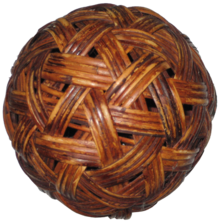Earliest evidence shows that the game was played in Malacca (Melaka), Malaysia's most historical city, in the 15 century, for it is mentioned in the famous Malay historical text, "The Sejarah Melayu" (Malay Annals). However, the game had undergone a significant change by the mid-1930s. In 1935, in the Malaysian State of Negeri Sembilan, during the Silver Jubilee celebration of King George V, 'Sepak Raga' was played on a badminton court over the net with players on both sides. Both badminton and 'Sepak Raga' rules were combined to form a new, very exciting game. Because the game was introduced during the Jubilee celebration, it was known as 'Sepak Raga Jubilee'.
It is not clear, but most probably, the game then gained popularity in Negeri Sembilan and spread to the other states. During World War II, the game developed rapidly in Penang. In the years after World War II right up to the early 'fifties', it was possible to see the game played in rural areas and towns all over the country - especially in areas where the Malay population was quite large.
It is believed that the development of modern Sepaktakraw is mainly due to three persons from Penang. In February, 1945 a net (Jaring) and rules similar to volleyball was introduced by Hamid Maidin. He had invited Mohamad Abdul Rahman (the best player with Raga Bulatan - or Circle Game) and Syed Yaacob to try his new twist on 'Net Sepak Raga'. They loved it because of the faster pace, the different styles of kicking and the higher standard of athleticism that it demanded.
The first official competition was held at a Swim Club on May 16, 1945. Teams from Malay villages in Penang were among those that competed for the Nyak Din Nyak Sham Trophy. The game, at this juncture, became known as " Sepak Raga Jaring". From that point on, the game spread quickly throughout the rest of the Malay Peninsula and South East Asia. By the late 'fifties' the game was popular in most schools that had badminton courts. Soccer players usually played it since they could easily master the skills involved, which are similar to those used in soccer. Sepak Raga associations had formed in various Malaysian states by this time as well.
The Malaysian Sepak Raga Federation was founded at a conference held at the Community Hall in Penang, June 25, 1960. Delegates from Kedah, Selangor, Negeri Sembilan and Penang attended. The first President was Mr. Mohd Khir Johari. Later the same year, representatives from various Southeast Asian counties met in Kuala Lumpur, Malaysia's capital city, to establish a standard set of rules and regulations for the game. To promote the game further in Malaysia, an inter-state competition was organised in 1962. Penang became the first holder of the Khir Johari Gold Cup. By then, Sepak Raga Jaring (Sepak Raga Net) had become one of the more popular games in the country, and today modern Sepaktakraw is Malaysia's national sport.
The prime opportunity to create more international recognition for the game came when Malaysia hosted the 1965 South East Asia Peninsular Games (SEAP Games, inaugurated in 1959). For the first time in the SEAP Games, this new sport was included as a medal event, but not before a lengthy discussion between Malaysian and Singapore delegates, on the one hand, and Laos and Thai delegates, on the other, with regard to the official name of the sport. The SEAP Games Committee eventually agreed that the sport would be known as "SEPAK TAKRAW". Sepak means "KICK" in Malay and Takraw means "WOVEN BALL" in Thai. Also in 1965, the Asian Sepaktakraw Federation (ASTAF) was formed to govern the sport in Asia, then in 1992 the International Sepaktakraw Federation (ISTAF) was formed as the world governing body for the sport.
Sepaktakraw has been on the move, being a medal event in the larger "Asian Games" held in Beijing, 1990, in Hiroshima, 1994 and in Bangkok, 1998. Women's events were introduced for the first time in an international tournament in 1997 at the Xlll King's Cup Sepaktakraw World Championships in Thailand. "Cirlce Sepak Takraw" (where 5 players who stand in a circle receive different levels of points for each successful passing kick - actually a modification of an earlier game that was popular in Thailand called Hoop Takraw), was introduced for the first time in the 1998 Asian Games. Also, making history in 1998, Sepak Takraw was introduced as a demonstration event in the Commonwealth Games held in Kuala Lumpur - seen for the first time in a non-Asian, international sporting event! Now there are enthusiasts in some 20 countries around the world that are playing Sepak Takraw.
How to play this games
This
game started with one of the players toss the ball to his hand. His friend that will fondle the ball
with his foot once or several times, before the kick to the other players. The players that make up the
environment or the circle must be rotation-rotation fondle the ball and control
it from falling to the ground. If
the ball falls, the game in the round ended.
 |
| the ball |
 |
| the players giving a service |














